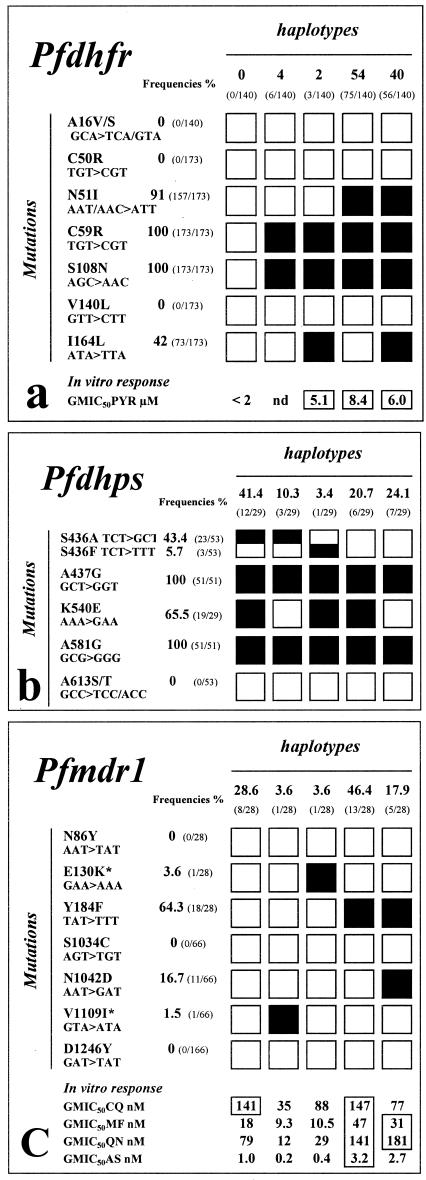FIG.2.
Sequence polymorphism in the Pfdhfr-ts, Pfdhps, and Pfmdr1 genes and resulting amino acid changes in clinical P. falciparum isolates from Cambodia as deduced by a PCR and direct sequencing strategy. Filled boxes show the position of the observed single nucleotide polymorphism for each haplotype. Empty boxes indicate a wild-type sequence at that position. The prevalence of the various mutations and haplotypes is indicated, as well as the in vitro responses of isolates to pyrimethamine (PYR), chloroquine (CQ), mefloquine (MF), quinine (QN), and artesunate (AS). In vitro responses are expressed as the GMIC50. (a) Pfdhfr-ts sequence polymorphism and its association with in vitro pyrimethamine resistance in 173 P. falciparum isolates from six different sites in Cambodia: Rattanakiri (n = 25), Snoul (n = 43), Kampong Speu (n = 21), Samlot (n = 17), Sampovloum (n = 62), and Anlong Veng (n = 5). (b) Pfdhps sequence polymorphism in 53 P. falciparum isolates from Rattanakiri (n = 2), Snoul (n = 26), Kampong Speu (n = 2), Sampovloum (n = 13), Samlot (n = 7), and Anlong Veng (n = 3). (c) Pfmdr1 sequence polymorphism and its association with in vitro susceptibility to a panel of antimalarials in 66 P. falciparum isolates from Rattanakiri (n = 2), Snoul (n = 21), Kampong Speu (n = 6), Sampovloum (n = 20), Samlot (n = 15), and Anlong Veng (n = 2). *, new mutations. The boxed GMIC50s indicate values above the threshold for in vitro resistance (16). In panel a, 95% confidence intervals observed for pyrimethamie were 5.07 to 14.0 μM (n = 26) and 3.06 to 11.8 μM (n = 27) for the ACIRNVI and ACIRNVL Pfdhfr-ts haplotype, respectively. In panel c, confidence interval values observed for the NEYSNVD (wild type), NEFSNVD, and NEFSDVD Pfmdr1 haplotypes were 69.0 to 288.2 nM (n = 6), 82.5 to 263.4 nM (n = 12), and 25.8 to 230.2 (n = 4), respectively, for CQ; 9.6 to 33.2 nM (n = 7), 27.2 to 81.6 nM (n = 13), and 16.9 to 55.6 nM (n = 5), respectively, for mefloquine; 33.0 to 187.8 nM (n = 7), 78.3 to 253.1 nM (n = 11), and 66.5 to 491.7 nM (n = 3), respectively, for quinine; and finally 0.56 to 1.65 nM (n = 7), 2.22 to 4.66 nM (n = 13), and 0.74 to 9.6 nM (n = 5), respectively, for artesunate. nd, no data.

